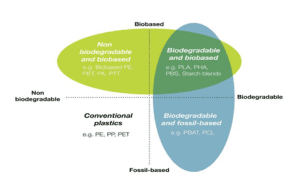TAG: GS- 3: ENVIRONMENT AND ECOLOGY
THE CONTEXT:
In recent years, microplastics have been reported as a major source of pollution affecting rivers and oceans.
EXPLANATION:
MORE ABOUT NEWS:
- The recent amendments to India’s Plastic Waste Management (Amendment) Rules, 2024, have introduced stricter criteria for labelling plastic products as “biodegradable”.
- Under the rules now require that biodegradable plastics must not leave any microplastics behind during the degradation process.
- This new stipulation aims to address concerns about microplastic pollution in the environment.
- The challenges associated with implementing these rules. One issue is the lack of specific guidelines regarding which chemical tests can accurately determine the absence of microplastics and to what extent microplastics must be reduced in a sample to be considered eliminated. The microplastics should be fair and applicable to both compostable and biodegradable plastics.
- The absence of clear standards has created uncertainty for manufacturers seeking to produce and label their products as biodegradable.
- The Central Pollution Control Board (CPCB) has been hesitant to provide provisional certificates to such manufacturers, as the rules do not specify the degree of degradation necessary to qualify for certification.
- The distinction between biodegradable and compostable plastics is significant and these are intended to mitigate plastic pollution, compostable plastics require specialized industrial or municipal waste management facilities for proper degradation, whereas biodegradable plastics are expected to decompose naturally over time.
ABOUT THE MICROPLASTICS:
They are tiny plastic particles and are defined as plastics less than five millimeters (0.2 inches) in diameter—smaller in diameter than the standard pearl used in jewelry.
There are two categories of microplastics:
- Primary: They are tiny particles designed for commercial use, such as cosmetics, as well as microfibers shed from clothing and other textiles, such as fishing nets.
- Secondary: They are particles that result from the breakdown of larger plastic items, such as water bottles. This breakdown is caused by exposure to environmental factors, mainly the sun’s radiation and ocean waves.
The problem with microplastics:
- It is that—like plastic items of any size—they do not readily break down into harmless molecules.
- Plastics can take hundreds or thousands of years to decompose—and in the meantime, wreak havoc on the environment.
- On beaches, microplastics are visible as tiny multicolored plastic bits in sand. In the oceans, microplastic pollution is often consumed by marine animals.
- Some of this environmental pollution is from littering, but much is the result of storms, water runoff, and winds that carry plastic—both intact objects and microplastics—into our oceans.
- Single-use plastics—plastic items meant to be used just once and then discarded, such as a straw—are the primary source of secondary plastics in the environment.
- They have been detected in marine organisms from plankton to whales, in commercial seafood, and even in drinking water. Alarmingly, standard water treatment facilities cannot remove all traces of microplastics.
- To further complicate matters, microplastics in the ocean can bind with other harmful chemicals before being ingested by marine organisms.
- Scientists are still unsure whether consumed microplastics are harmful to human or animal health—and if so, what specific dangers they may pose.
- Even so, many countries are taking action to reduce microplastics in the environment. A 2017 United Nations resolution discussed microplastics and the need for regulations to reduce this hazard to our oceans, their wildlife, and human health.

Biodegradable plastics
- Biodegradable plastic is plastic which degrades under biological (mainly microbial) action. Some biodegradable plastics are compostable (but not all), which means they degrade under controlled conditions, such as those occurring at compost (or anaerobic digestion) sites.
- Different biodegradable plastics only degrade under certain specified and tested conditions (g. degradable in soil, in wastewater treatment plants, etc), but most need industrial composting facilities, which, as we’ll argue further on, is their reasonable destination.
- They may biodegrade in open environment, but the speed at which this occurs is wide-ranging, and related test methods and standards are not sufficiently defined and universally accepted.
- Compostable plastics need to further adhere to a set of requirements such as fragmentation, absence of ecotoxicity and threshold concentrations of potential pollutants such as heavy metals.
Bioplastics, Bio-based, Biodegradable, Oxo-plastics
| Term |
Description |
Example |
| Bioplastic |
|
Cornstarch bag |
| Bio-based |
|
Bio-based PET bottle (might not be biodegradable) |
| Biodegradable |
|
Compostable bag |
| Oxo-degradable |
|
“Eco-friendly” shopping bag (likely not good for the environment) |

WHAT IS THE SINGLE-USE PLASTIC?
- It is most commonly used for packaging and serviceware, such as bottles, wrappers, straws, and bags.
- It is plastic we use once and throw away, often as quickly as minutes, such as disposable cups at parties.
- Half of the plastic produced each year is single use, which is nearly the same weight as the entire human population.
- A lot of single-use plastic ends up in our oceans, and by 2050, there will be more plastic in our ocean than fish.


